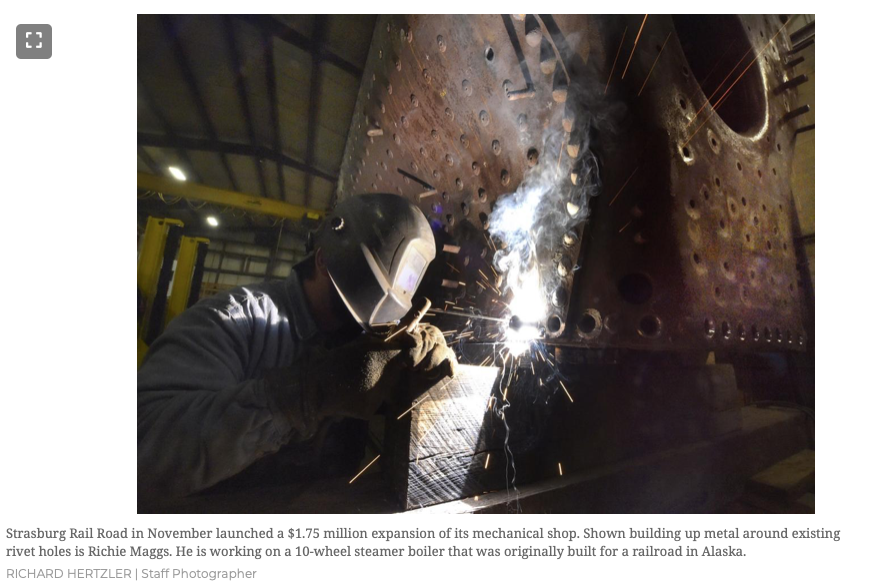
https://lancasteronline.com/news/local/locomotives-find-new-life-among-the-crash-and-bang-of/article_e44aa1be-b802-11e6-925e-971ab2fd317b.html

TOM KNAPP | Staff Writer | December 3, 2016
Richie Maggs leans into the boiler of a disassembled steam locomotive, sparks showering around him as he welds new metal to thicken and strengthen worn steel.
Around him, the room echoes with the sounds of crashing metal and small motors.
"This is actually a quiet day," he says with a grin.
Maggs heads the mechanical shop at Strasburg Rail Road, where engines and passenger cars come from around the world to be restored, repaired or rebuilt, as needed.
The shop, some 18,000 feet square, is in the midst of an $1.75 million expansion project that will add some 12,000 square feet to its footprint.
It's just a few hundred yards from the heart of the Strasburg Rail Road terminal, where tourists flock each year to experience the heyday of American train culture.
It's one of only a handful of shops like it in the country, Maggs says.
With the expansion, says station master Steve Barrall, "we'll be able to do more, on a greater scale."
"We'll be able to help out more museums that need our expertise," he says. Gesturing around the work area, he adds, "things are quite cluttered. The lack of space really hinders what we can do."
The shop -- which includes a large area for metal work, a smaller room for carpentry and a third area for "secret" projects -- divides its time between work on equipment owned by Strasburg Rail Road and equipment trucked in from railroads and museums around the world, Barrall says.
The larger shop means they'll be able to take in more contract work, he explains.
Maggs says it also means they'll add six full-time workers to a team of two dozen.
Their employees are welders, mechanics, machinists and boilermakers, he says. But the work they do at Strasburg is so specialized, Maggs says, it requires on-the-job training.
"They don't teach this stuff in classrooms any more," he says. "Most of the people who work here come in with skills, but we still have to start from scratch."
An interest in history is also useful, he says -- as is a passion for tinkering.
"It's a dirty job, and it's loud," Maggs says, fingering a hole burned through both his coat and shirt sleeves. "It's a dangerous job, but most everybody here really has their heart in it."
Chartered in 1832, Strasburg Rail Road is the nation's oldest short-line railroad. Today, some 300,000 tourists visit each year.
"I've been here almost 12 years," Maggs says. "In that time, we've grown 400 percent or so. For us, business is booming."
The shop must expand, he explains, because they're working on 100- to 200-ton locomotives and massive passenger cars that take up a lot of room.
"We used to have one or two projects a year," he says. "Now I have seven going simultaneously."
Jobs range from tooling a small part needed to repair an engine to rebuilding an entire locomotive. Some projects can be handled quickly, he says, while others can take years to complete.
For instance, he points to a hulking narrow-gauge engine in the corner of the warehouse-like shop. It's the Rio Grande Southern No. 20, an 1899 showpiece for the Colorado Railroad Museum, which has been an on-again, off-again project in Strasburg since 2007.
They're rebuilding the entire locomotive, Maggs says, after it sat unused for more than 50 years.
Each project may need four to six months just to evaluate its needs, he says. Since they often work without original design specifications, the team sometimes must reverse engineer the technology to make it work.
They also have to take modern safety regulations into account, he adds; boilers and wheels, for instance, must adhere to much stricter guidelines than were in effect a century ago.
"We try to keep as much of the original fabric of a historically significant locomotive as we can," Maggs says.
Even so, he says, the Colorodo engine will probably be 35 to 40 percent new material by the time the work is done.
"We're pretty proud of the fact that we can repair pretty much anything," he says. "I don't think anything has ever come in that we couldn't do something with."
Although the biggest attraction at Strasburg Rail Road is the trains, station master Steve Barrall says the mechanical shop is open for tours for anyone interested in seeing the work in process.
Tours are offered at noon on days the passenger trains are running, he says. Tours also can be scheduled by special arrangement.
"For the most part, people who are riding our trains don't have any idea what's going on in here when they go by," Barrall says.
Tickets cost $18. No one under the age of 5 is allowed in the shop, and children ages 5 to 15 must be accompanied by an adult.